| Araneae
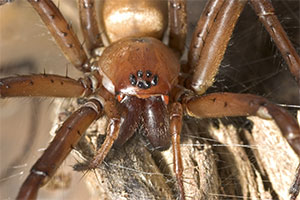 Cambridgea foliata
Cambridgea foliata, a large native New Zealand spider.
with Jessica Costall
Common name: spiders.
Scientific name: phylum Arthropoda, class Arachnida, order Araneae. From Latin “arane” – meaning a spider, or spider’s web.
Description
Spiders belong to the class Arachnida, along with harvestmen, pseudoscorpions, mites, and scorpions. Spiders are a diverse group, with much variation in size, body form and colouration. Most ground-dwelling spiders in New Zealand are various shades of back, grey or brown, but a few are brightly-coloured.
The
body of a spider consists of two major parts: the anterior
cephalothorax and the posterior abdomen, which are connected
by a narrow waist. The cephalothorax, which is a fused head and thorax, is
covered by a dorsal and a ventral sclerotized plates; the abdomen
is much softer and more flexible by comparison.
At the posterior end of the abdomen are the spinnerets which the spider uses to exude and spin threads of silk. The cephalothorax bears the
sensory organs, mouth parts, and the four pairs of walking
legs. The most noticeable feature of spider mouthparts is
a pair of fang-like chelicerae for biting prey and
injecting venom. There is also a pair of leg-like pedipalps.
In male spiders the pedipalps have been modified for sperm
transfer, a peculiar feature which is unique to spiders. Each
of the eight walking legs has seven segments, with the terminal
segment bearing claws, which are used for traction. Legs and
body of spiders are usually very hairy, these hairs have a
tactile sensory function.
Spiders possess up to eight simple eyes or ocelli, each of
which consists of a single lens. The eyes are positioned near
the front of the cephalothorax, with their arrangement characteristic
for different spider families. All New Zealand spiders have
either six or eight eyes, but species elsewhere can have four,
two and even a single eye. With the exception of the jumping
spiders (family Salticidae) eyesight in spiders is poor -
they are limited to detecting movement and changes in light
intensity.
Ground-dwelling spiders can be found in a variety of habitats in New Zealand, from coastal sand dunes, to pasture, to native forest. Some of the common ground-dwelling spiders are described below:
Mygalomorphae - the trapdoor spiders
The Mygalomorphae are spiders that possess paraxial chelicerae, which means that they strike downwards with their fangs, and have a more primitive respiratory system. They tend to be larger than other spiders. This group is commonly referred to as the trapdoor spiders. New Zealand has four families of mygalomorph: Hexathelidae, Nemesiidae, Idiopidae, and Migidae. Migidae spiders are restricted to above-ground habitats and are thus not discussed further.
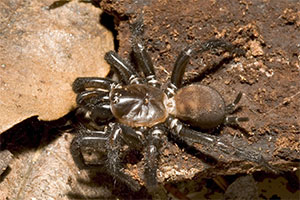 Hexathele sp.
Hexathele sp., a tunnel web spider. Hexathelidae - the tunnel web spiders - are New Zealand's largest mygalomorphs, and the heaviest of all New Zealand spiders, with many exceeding 3 cm in body length. They can be recognized by two extremely long spinnerets. Hexathelids often construct long, loosely woven tunnel webs under logs or stones. Prey items are snatched at the open end of the tunnel and are dragged back into the retreat to be eaten. Arthropods make up the bulk of their diet; one species is known to prey upon snails. These spiders spend most of their time within their retreats, and are rarely associated with human habitation. However, occasionally males that are searching for mates may end up inside houses. Bites from these spiders are rare, but if they do occur, symptoms are generally limited to localized pain and inflammation.
Nemisiidae construct open burrows in the ground. They are similar to the hexathelids, but can be distinguished by their generally pale abdominal colouration and mottled pattern. Idiopidae are the true trapdoor spiders, and all construct burrows within the ground. Some species construct thin lids over their burrow entrances, while others leave the tops open. If a lid is constructed it is never a heavy plug like those observed in overseas trapdoor spider species. Idiopid spiders are characterized by possessing strong spines on their chelicerae, which are used in digging and constructing burrows. Some members of the family Idiopidae build open tunnels on the forest floor. Other species in this family are common in native tussock lands and pasture, and construct burrows which can extend down into the soil to depths of 20-25 cm. These spiders remain in their burrows for much of the time and tend not to be noticed by humans.
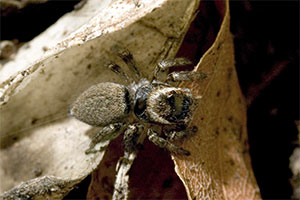
Jumping spider - family Salticidae. Jumping spiders - family Salticidae
Jumping spiders have the keenest eyesight of all spiders, with eyes that are capable of forming images. This excellent eyesight is important as jumping spiders actively hunt their prey during daylight. As their name suggests, jumping spiders are capable of leaping large distances when they pounce on their prey. Most New Zealand jumping spiders are patterned in shades of brown, black, grey and white and can be between 2-10 mm in length. Males are often bright-coloured and can be recognised by their enlarged front legs, which they use in mating displays. Jumping spiders are most commonly seen in warm, sunny spots such as on concrete paths, stones, or fences.
Wolf spiders - family Lycosidae
Wolf spiders do not construct webs for prey capture, and are often seen running quickly across the ground during the day. Although most New Zealand wolf spiders are shades of grey or brown, many have yellow or orange markings visible upon closer inspection. Most have mottled patterns that make them extremely well-camouflaged. Wolf spiders have good eyesight that allows them to detect movement, although they cannot perceive shapes like salticid spiders can. New Zealand wolf spiders tend not to construct burrows, and instead hide in cracks or at the bases of vegetation. Female wolf spiders carry their eggsacs firmly attached to the abdominal spinnerets, and then carry spiderlings on their backs for about a week after they hatch, which is a level of parental care that is unique to this family. Lycosid spiders occupy a wide variety of habitats, including riverbeds, coastal areas, alpine zones, gardens, pasture and forest.
Sheetweb or Money spiders - family Linyphiidae These spiders are generally small (<3 mm long), with long skinny legs that bear prominent spines. Most species are patterned in shades of grey, brown and black. These are the most abundant spiders found in pasture and other grasslands, but some species can be found in leaf litter and other debris. Most Linyphiids in New Zealand are native, but the two introduced species are very abundant and are thus commonly encountered.
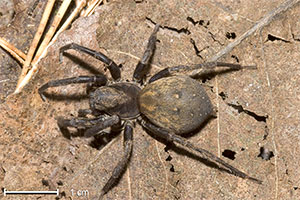 Uliodon sp.
Uliodon sp., the large forest-dwelling prowling spider.
Prowling spiders - family Zoropsidae
New Zealand prowling spiders are large, grey or brown, and comparatively bulky. Most species live in forests. They are nocturnal ground hunters so during the day they are found hiding within their retreats under logs or stones.
Hopping spiders - family Clubionidae
This family has a cosmopolitan distribution. Most New Zealand clubionids live in open areas such as grasslands, and can be found within this vegetation or under stones. Some clubionids can be found if forest leaf litter. Most are pale brown in colour, with either dark spots or bands on their abdomen. When disturbed these spiders will hop into the air, but unlike jumping spiders they land in almost the same position, rather than covering long distances.
Crab spiders - family Thomisidae
Most crab spiders live above ground in vegetation. However, one group of crab spiders - the blunt-ended spiders (genus Sidymella) live in leaf litter and other forest floor debris. Sidymella spiders are all cryptically-coloured, and have been named for their distinctive triangular-shaped abdomen.
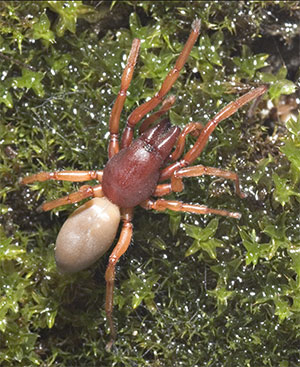 Dysdera crocata
Dysdera crocata, the slater-eating spider.
Slater spider - family Dysderidae
This group is not native to New Zealand. The only commonly encountered member of this group is the cosmopolitan slater spider - Dysdera crocata. This large spider is often found in soil, compost, or leaf litter in gardens and other urban environments, and can be immediately recognized by its bright reddish cephalotorax and legs, silvery-cream abdomen, and rather fearsome-looking large chelicerae. Dysdera crocata feeds on slaters (Isopoda).
Midget spiders - family Anapidae
All of the previously mentioned spiders are large and comparatively conspicuous compared to Anapidae, whose body length never exceeds 1.5mm. Despite their small size, midget spiders are important members of leaf litter communities, preying on small invertebrates such as collembola. These spiders actually construct tiny orbwebs within the leaf litter. The distinguishing feature of this family is a marked upgrowth in the head region of the carapace, which gives them a rather bizarre appearance. A hand lens will be essential to examine these tiny spiders. The distribution of this family is largely restricted to New Zealand and Australia.
Notes on biology
All spiders are carnivorous. Some spiders
are sit-and-wait predators and use webs to catch their prey,
while others actively hunt their victims. Most spiders are
generalist and opportunistic feeders, feeding on a wide range
of mostly invertebrate prey. Some of the largest spiders are
known to feed on small vertebrates. Spiders bite their prey
and inject venom which contains poison and digestive enzymes.
While all spiders feed on the partially digested internal
body fluids of the prey item, some will leave the exoskeleton
of the prey item intact while others will thoroughly chew
their prey items, leaving behind only mangled non-digestible
parts.
Spiders grow through a series of moults
like all other arthropods, and generally stop moulting at
maturity. Sexual dimorphism is common in spiders, with males
generally smaller and shorter-lived than females. For many
spider groups it is the males that are most commonly encountered
by humans, as male spiders wander around in search for females,
which often remain stationary.
Most spiders have well-developed courtship
displays and behaviours. After mating, the female lays a clutch
of eggs and encases them in an often densely-woven silk case.
Once the eggs hatch the spiderlings continue to develop within
the eggsac, and many will undergo moults before they hatch
out. Parental care, if it occurs, is often limited to guarding
of the eggsac by the female (the exception being the wolf
spiders – family Lycosidae, which have well developed
parental care).
Where to find them?
Ground-dwelling spiders are common in New
Zealand. Many species are nocturnal and will spend the day
hiding in retreats. Spiders can be found in leaf litter, but
if searching during the day you will need to look under logs,
stones, and in the base of vegetation, as this is where there
webs or retreats are likely to be located. Many spiders have
a reflective layer of crystalline cells in their eyes, and
therefore can be easily spotted at night while using a flashlight.
Their eyes will appear as tiny pinpoints of light in front
of a torch beam.
Not all spiders are large and conspicuous, and it can be
helpful to use a magnifying glass or hand lens to examine
some spiders, particularly the small ones that are commonly
found in leaf litter. Putting samples of leaf litter into
a white tray and using a small paint brush to sift through
will increase your chances of spotting some of the smaller
spiders.
Spiders are not limited to damp habitats like some other invertebrate
groups, and thus can not only be found in forest, but in coastal
habitats, riverbanks, pasture, gardens, and even in alpine
areas.
Despite common preconceptions the vast majority of spiders
are harmless to humans, but some of the larger spiders are
capable of giving a painful bite. The only spiders in New
Zealand that are capable of causing death in humans are the
two species of katipo spider: Latrodectus katipo
and Latrodectus atritus. Both live in the bases of
vegetation or under driftwood and other debris, and are restricted
to coastal dune systems. Katipo spiders are not aggressive
however, so field observations of these spiders will be safe
as long as due care is taken. Effective anti-venom is available
at hospitals. In the case of a spider bite always seek medical
advice.
If you want to collect spider specimens, they are best preserved
in alcohol. However, the identification of spiders is difficult,
and many New Zealand spiders remain undescribed. Accurate
identifications are best left to taxonomic experts, therefore
observations of live spiders in the wild, combined with photography,
are the best options for amateur spider enthusiasts.
Distribution and conservation
Spiders are common throughout the world,
occupying a wide range of environments. Currently 39000 species
from 110 families are recognized worldwide. New Zealand’s
spider fauna contains 49 families, 5 of which are introduced
to New Zealand. The total number of recognised species in
New Zealand is just over 1060. However, there are many undescribed
species so the actual number is likely to be much higher.
Of those spiders, about 980 can potentially be found at ground
level. Spiders can be found throughout New Zealand, in natural
habitats and in areas of human habitation.
The taxonomic assignments of spiders have changed many times,
and many groups are still under revision. Although the general
physiology of spiders has been studied extensively, little
is known about spider ecology. In New Zealand, the distribution,
diversity, and ecology of our native spider species is virtually
unknown.
Many exotic spider species are established in New Zealand,
including members of five families that are not represented
by the native fauna. Some well-known introduced species include
the white-tailed spider Lampona cylindrata, the Avondale
spider Delena cancerides, and the Australian redback
Latrodectus hasselti.
New Zealand has a small number of endangered spider species,
although it is likely that there are many more spiders under
threat whose status remains unknown. One of the most widely-known
endangered spiders is the red katipo spider, Latrodectus
katipo. A close relative of the Australian redback, it
is limited to coastal dune habitat and has declined in abundance
due to habitat loss.
Included images:
- Family Hexathelidae
- Hexathele
sp. - Palmerston North, WI, North Island (2 images)
- Hexathele
sp. - Trounson Kauri Park, Northland, ND, North Island
- Porrothele
sp. - Rimu Valley Walk, SD, South Island (2 images)
- ?Porrothele
sp. - Craigieburn Forest Park, Cave Stream, NC, South
Island (2 images)
- Family Stiphidiidae
- Cambridgea foliata
(L. Koch, 1872) - Ohinetonga Scenic Reserve, TO, North
Island (4 images)
- Cambridgea
sp. juvenile - Temple Valley, Lake Ohau, NC, South Island
- Cambridgea
sp. - Temple Valley, Lake Ohau, NC, South Island
- Family Tetragnathidae
- Orsinome lagenifera
(Urquhart, 1988) - Katikara Stream, Taranaki, TK, North
Island (3 images)
- Family Zoropsidae
- Uliodon (formerly
Miturga) sp. - Palmerston North, WI, North Island
- Uliodon (formerly
Miturga) sp. - Canaan Road near Harwood Hole,
NN, South Island
- Uliodon (formerly
Miturga) sp. - Lake Alexandrina, MK, South Island
- Family ?Zoropsidae
- ?Uliodon
sp. - Peel Forest Park, Dennistoun Bush, SC, South Island
- Family Cycloctenidae
- Cycloctenus
sp. - Karori wildlife sanctuary, WN, North Island
- Cycloctenus
sp. - Canaan Road near Harwood Hole, NN, South Island
(2 images)
- Cycloctenus
sp. - Rimu Valley Walk, SD, South Island (2 images)
- Cycloctenus sp.
- Craigieburn Forest Park, Cave Stream, NC, South Island
(3 images)
- Family Amphinectidae
- Amphinecta
sp. - Canaan Road near Harwood Hole, NN, South Island
(2 images)
- Amphinecta
sp. juvenile - Blue Duck Reserve, KA/NC, South Island
- Family ?Amphinectidae
- Unidentified species
- rimu valley Walk, SD, South Island
- Family Thomisidae
- Unidentified sp.
- Torlesse Range, Porters Pass, NC, South Island
- Family Lycosidae
- Allotrochosina
schauinslandi (Simon, 1889) - Craigieburn Forest
Park, Cave Stream, NC, South Island
- Anoteropsis adumbrata/hilaris
(Urguhart, 1887/L. Koch, 1877) - Torlesse Range, Porters
Pass, NC, South Island (2 images)
- Family Gnaphosidae
- Notiodrassus distinctus
(Bryant, 1935) - Temple Valley, Lake Ohau, NC, South
Island (2 images)
- Family ?Gnaphosidae
- Unidentified species
- Torlesse Range, Porters Pass, NC, South Island
- Family Pisauridae
- Dolomedes
sp. undescribed - Temple Valley, Lake Ohau, NC, South
Island (2 images)
- Family Salticidae
- Hypoblemum albovittatum
(Keyserling, 1882)* - Nelson, NN, South Island
(4 images)
- Unidentified species
- The Remarkables, Lake Alta (~1750m), Central Otago,
CO, South Island (2 images)
- Unidentified species
- Old Man Range (~1660m), Central Otago, CO, South
Island (2 images)
- Family Agelenidae
- Neoramia alta
Forster & Wilton, 1973 - The Remarkables, Lake
Alta (~ 1750m), Central Otago, CO, South Island (2 images)
- Neoramia alta Forster & Wilton 1973
- Old Man Range (~1660m), Central Otago, CO, South
Island (2 images)
- Family Theridiidae
- Steatoda carpensis
(Hann, 1990)* - Nelson, NN, South Island
- Steatoda carpensis
(Hann, 1990)* - Kaiteriteri Road, NN, South Island (5
images)
- Family Dysderidae
- Dysdera crocata
(C. L. Koch, 1838)* - Palmerston North, WI, North Island
(2 images)
- Other
- Unidentified species
- Lake Coleridge, Central Otago,
CO, South Island
- Unidentified species
- Palmerston North, WI, North Island
- * - species exotic in NZ
Further information on New Zealand
spiders:
Blest, A.D., and P.W. Taylor. 1995. Cambridgea
quadromaculata n.sp. (Araneae, Stiphiidae): A large New
Zealand spider from wet, shaded habitats. New Zealand Journal
of Zoology 22, p. 351-356.
Foelix, R.F. 1996. Biology of Spiders.
Oxford University Press, New York. 330 pp.
Forster, R.R. and L.M. Forster. 1999. Spiders
of New Zealand and their worldwide kin. University of Otago
Press, Dunedin, New Zealand. 270pp.
Hann, S.W. 1994. Descriptions of 4 Steatoda
species (Araneae, Theridiidae) found in New Zealand. New Zealand
Journal of Zoology 21, p. 225-238.
Jackson, R.R., and M.B. Willey. 1995. Display
and mating behavior of Euophrys parvula, a New Zealand jumping
spider (Araneae, Salticidae). New Zealand Journal of Zoology
22, p. 1-16.
McLachlan A.R.G., and S.D. Wratten. 2003.
Abundance and species richness of field-margin and pasture
spiders (Araneae) in Canterbury, New Zealand. New Zealand
Journal of Zoology 30, p. 57-67.
Patrick, B. 2002. Conservation status of
the New Zealand red katipo spider (Latrodectus katipo
Powell, 1871). Science for Conservation 194, 33 p.
Platnick, N.I. 2000. A relimitation and
revision of the Australasian ground spider family Lamponidae
(Araneae : Gnaphosoidea). Bulletin of the American Museum
of Natural History 245, p. 3-330.
Raven R.J., and K. Stumkat. 2003. Problem
solving in the spider families Miturgidae, Ctenidae and Psechridae
(Araneae) in Australia and New Zealand. Journal of Arachnology
31, p. 105-121.
Taylor, P.W., and R.R. Jackson. 1999. Habitat-adapted
communication in Trite planiceps, a New Zealand jumping
spider (Araneae, Salticidae). New Zealand Journal of Zoology
26, p. 127-154.
Vink, C. 2002. Lycosidae (Arachnida: Araneae).
Fauna of New Zealand 44, 94 pp.
Vink, C.J., and A.M. Paterson. 2003. Combined
molecular and morphological phylogenetic analyses of the New
Zealand wolf spider genus Anoteropsis (Araneae :
Lycosidae). Molecular Phylogenetics and Evolution 28, p. 576-587.
Vink, C.J., Teulon, D.A.J., McLachlan, A.R.G.,and
M.A.W. Stufkens. Spiders (Araneae) and harvestmen (Opiliones)
in arable crops and grasses in Canterbury, New Zealand. New
Zealand Journal of Zoology 31, p. 149-159.
Whitehouse, M.E.A. 1986. The foraging behaviours
of Argyrodes antipodiana (Theridiidae), a kleptoparasitic
spider from New Zealand. New Zealand Journal of Zoology 13,
p. 151-168.
Zabka, M. and S.D. Pollard. 2002. Hinewaia,
a new genus of Salticidae (Arachnida : Araneae) from New Zealand.
Annales Zoologici 52, p. 597-600.
Zabka, M., Pollard, S.D. and M. Anstey.
2002. Zoogeography of Salticidae (Arachnida : Araneae) of
New Zealand - First approach. Annales Zoologici 52, p. 459-464.
Spider Resources on the Web:
The
Tree of Life - Araneae,
gives phylogenetic relationships within the order, and lists
the references and websites about Araneae.
International Society
of Arachnology, by the International Society of Arachnology,
contains many links to other spider-related websites and details
regarding membership of the Society.
Spiders, by G. Crew,
contains information and photos of spiders, especially Australian
species, and news clippings regarding spiders from around
the world.
Spiders
in New Zealand, by Landcare Research New Zealand, gives
information on the White-tailed spider (Lampona murina)
and the Avondale spider (Delena cancerides); both
are introduced species.
Spiders
of Australia, by E. Nieuwenhuys and R. Loggen, contains
many photos of Australian spiders and links to sites regarding
Australian spider families.
Spiders-of-Australia, by Guardian Insurance, contains a collection of links to photos, descriptions, and biology of common Australian spiders.
Spiders
of New Zealand, by P. Sirvid and R. Palma, Te Papa - The
Museum of New Zealand. This site has information on a small
range of New Zealand spiders; both native and introduced.
It has a guide to the identification of some commonly encountered
spider species, and answers to some frequently asked questions
about spiders.
The
American Arachnological Society, by the American Arachnological
Society, contains information regarding the biology of spiders
and other arachnids, and access to online issues of the Journal
of Arachnology. Also contains links to other spider websites
and a photo gallery.
The
World Spider Catalog, Version 5.5, by Norman I. Platnick,
The American Museum of Natural History. This website is regularly
updated, and contains current numbers of recognized spider
species, genera and families.
Australian
Faunal Directory: Checklist for ARACHNIDA: Araneomorphidae,
by the Department of Environment and Heritage, checklist of
Australian fauna, with distribution information and bibliography,
with some notes on ecology.
Bryce McQuillan's photo gallery - NZ insects and spiders
|